
Porkchop pounds a T-Stake into the desert floor, helping to build the fence that surrounds the perimeter of Burning Man's temporary metropolis, Black Rock City. Via The Burning Blog. Courtesy John Curley.
When I first found out about the Black Rock City Department of Public Works, it was like finding out that Santa Claus did not exist. I was disappointed, and a little bit embarrassed by my own naivete. Of course I loved Burning Man for the limitless expanse of art, but I also felt in awe of its total DIY spirit. The Black Rock Desert, known affectionately as the playa, is one of the largest mud flats on the planet, spanning 1,000 miles. The alkaline quality of the canvas-colored dust is inhospitable to almost any life form, a post-apocalyptic tabula rasa alienscape upon which Burning Man’s Black Rock City develops and disappears each year. Since there is no vending allowed at the event, one has to bring enough food and water. Although there are porta potties, camps must also minimize their footprint by engineering some sort of greywater system for their makeshift kitchens. The sun is merciless, and wind gusts can exceed 50 mph, so you can’t just bring any old pop-up tent and call it a day. Shelter and shade structures must be built with creativity and ingenuity. Geodesic domes, yurts, and wigwams often dominate the architecture of Black Rock City—not just out of some countercultural fetishization of Buckminster Fuller or nomadic indigenous people, but because they are the most practical structures for that environment.
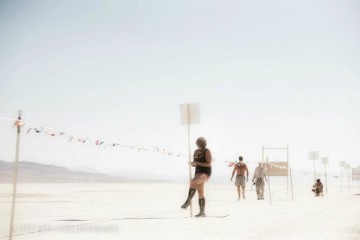
The Sign Shop spends much of July painstakingly creating over 1,000 signs. In August, they install them along the freshly-surveyed roads of Black Rock City. Via The Burning Blog. Courtesy John Curley.
So here I was, thinking that myself and the tens of thousands of other participants at Burning Man were building this whole thing from scratch year after year, without any help from The Man. Our own metropolis, culture, and living art museum all in the span of six days. And on the seventh day, we burned it. Leaving no trace. Whatsoever. End of story.
And for the first 10 years of Burning Man’s existence, that was the end of story. But while the pervasive Leave No Trace ethic of Burning Man stems mostly from an interest in preserving the exquisite public land of the Black Rock Desert, the whole shebang hinges on meeting strict permit stipulations imposed by the Bureau of Land Management. Incidentally, most proceeds from those high ticket prices go directly toward the cost of said land use permits.
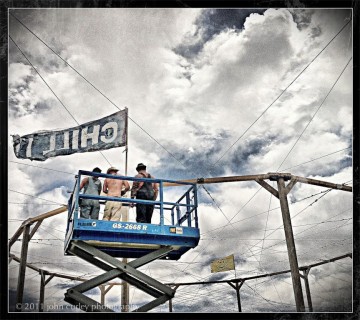
The Arctica Crew works on one of the sites where participants can purchase ice--essentially the only vending allowed on the playa. Proceeds from ice sales benefit local schools. Via The Burning Blog. Courtesy John Curley.
As Black Rock City’s population grew each year, it became increasingly difficult to meet the permit stipulations. So in 1997, the Department of Public Works was formed to plan the city, help implement those plans, and make sure that, while most participants pack everything out, no trace whatsoever is left – no tiny feathers, no big dunes, no soot. The original DPW was founded by four individuals: Will Roger Peterson aka Mr. Klean, Flynn Mauthe aka Bobby Wayne, Rod Garrett aka Ramrod, and Tony Perez aka Coyote. (Many Burners have “playa names” for the event, and DPW all but requires it. My alias is Struggles.)
Rod Garrett made the first official city plan back in 1997, and has continued to design the city each year since. Sadly, this year’s iteration of Black Rock City is the last one designed by Rod Garrett, as he passed away this summer, just one week before the event began. Meanwhile, Coyote, whose title is now Black Rock City Superintendent, has surveyed the city every year since the inception of DPW (except 1999, when Playground recounts taking the reigns) and he continues to work daily alongside the now 200-some DPW crew members. Many members of the crew begin working in July, and stay until October.
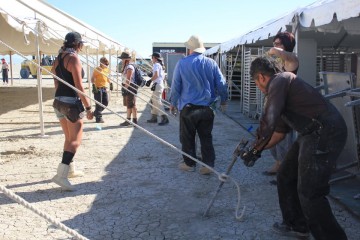
Building the giant Commissary tent, where all DPW crew meals are prepared and served on the playa. Courtesy Michal Katz aka Cuddle Fish.
DPW consists of roughly three dozen different crews, all in charge of various aspects of the city’s physical infrastructure. To name a few, Sign Shop cuts, designs, paints, stencils, and installs more than 1,000 signs on every street of the city; the Power Crew digs and builds an expansive grid of power lines connecting generators to other DPW work sites, official camps, and honorarium installations; the Bike Crew maintains the fleet of community “yellow bikes”; the Man Base and Man Krew build the iconic Man sculpture and its (typically elaborate and theme-inspired) base, which towered at a record-breaking 104 feet this year.
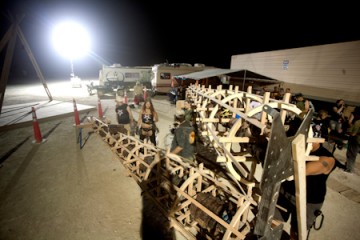
DPW members add waxed burlap to the Man Sculpture before it gets placed on the Man Base. The wax helps the man catch fire better on the night of The Burn. Via The Burning Blog. Courtesy John Curley.
So let me muddle my original metaphor a bit: finding out about DPW was actually more like finding out that Santa Claus relies on the help of a couple hundred elves and a dozen flying reindeer. Of course my immediate response was: where do I sign up to become one of those elves? Or flying reindeer?
It turns out that the competition is pretty stiff. Rumor has it that over 700 people applied to join the DPW this year. So of course it took a couple years of pleading with the volunteer coordinator, and reshuffling my own life, before I could ditch everything to spend one month living in a tent in the desert, with dust covering every square inch of my belongings, bed, body, and brain.
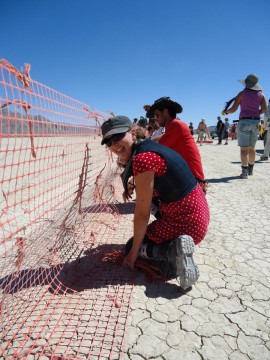
Fence Manager Miss Marlie and crew tying part of the nine mile stretch of fence that surrounds Black Rock City. Courtesy Leslie McLaughlin.
On August 8, three weeks before the event begins, the entire DPW force works together to lay out nine miles of fence in a pentagon formation, pounding 1,600 t-stakes into the ground and tying the 4-foot orange plastic fence by hand. The fence at once creates a secure barrier against interlopers, and catches any bits of trash—better known as MOOP, or matter out of place—that might get carried off by the wind, helping to ensure that Burning Man Leaves No Trace.
Although I foolishly showed up a couple days after Fence Day, I got to work on Fence Crew some weeks later, once Burning Man began. Event-time Fence Crew patrols the perimeter to collect MOOP caught by the fence, repair damages in the fence, and on the last day, build a new fence around the Man sculpture. During the week, participants are allowed to enter the Man Base and climb up inside the sculpture. But 24 hours before it burns, all participants must clear out while the fire team loads the effigy with fireworks and pyrotechnic kindling.
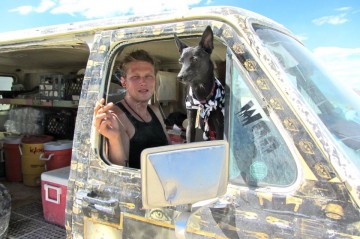
Viva L'Amour on his route in the Fluffer Van, with P-Fluff's dog, Puppy La Pue, aka Chloe. Dogs are not allowed at Burning Man, but crew members working before and after are sometimes allowed to bring pets. Courtesy Jamie Hiltabedel aka Red Pandamonium.
But let’s not get ahead of ourselves. My first DPW gig was as a member of the Fluffer Team. With all resources trucked in from afar, there are only a few sites where DPW can set up potable water, yet the crews must work all over the roughly 6-square-mile expanse in the hot sun. Every day, the Fluffers fill dozens of water coolers at the Commissary water station, and divide up into three vans. Each van has a set route, checking on the water supply of specific crews, refilling, sanitizing, and hauling around 55-lb coolers of ice and water.
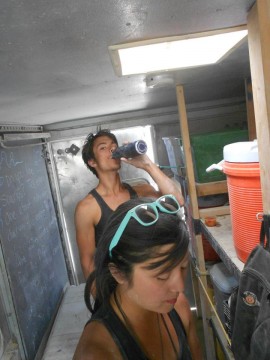
Where the magic happens: Lil Girl and Cougarbait inside the Fluffer Wagon. Courtesy Sarah Schaan.
In tales of DPW days of yore, workers survived mostly on beer and their own supplies, but nowadays it is also the Fluffers’ job to offer the little things—snacks, sunscreen, soda, and the occasional pep talk—that make working long hours, seven days a week, more fun than grueling. Most DPW members are volunteers, and while each worker receives a comped ticket to the event and three square meals a day, sometimes it takes a little extra to keep unpaid workers happy. As an extreme extrovert, I loved fluffing. Instead of just getting to know the members of my crew, I had the chance to meet and chat with almost everyone on DPW in just a few days. But as a DPW rookie, I wanted to play the field.
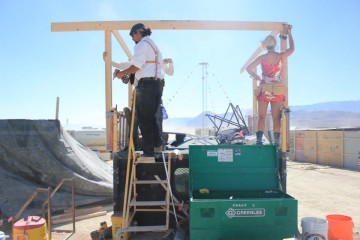
Crazy Talk and the author building shade on top of "Priscilla," the Shade Crew work vehicle. Courtesy Michal Katz aka Cuddle Fish.
After a week of fluffing, I found myself in the clutches of the tireless Shade Crew. While event participants are responsible for constructing their own shade systems to survive the daytime heat, the DPW Shade Crew builds shade structures for communal areas, other crews, and the on-playa bureaucracy that has developed as Burning Man has expanded. Shade Crew now builds around 80 structures, for teams such as the Department of Mutant Vehicles, which registers a curated selection of art cars and inspects them to make sure each vehicle is sufficiently transformed; the Artery, which coordinates with artists and places art installations; Media Mecca, which facilitates embedded journalists; the Emergency Services Department, where volunteers and participants alike can seek both emergency and non-emergency care; and Gate Crew, which collects tickets at the entrance, and searches cars for stowaways. (While working a gate shift during the event, I used my excellent sleuthing skills to detect a counterfeit ticket. It all felt very James Bond.)

Shade Crew member stretching shade cloth over the wooden frame structure, one of 80 shade structures built on the playa. Courtesy Tiffany Sinacola aka Lucky Charms.
Each structure must withstand gale-force winds, and protect large groups of people from the sun. Building the structures is a bit like simultaneously raising a barn and stretching a canvas. Given the latter comparison, you might think I would be a natural, since I’m a painter. But now think about my aforementioned playa name, Struggles.
The irony of Shade Crew is that we rarely find ourselves enjoying the fruits of our labor. We balance on ladders in the blazing heat building one structure, and then immediately move on to the next. Shade’s unofficial tag line is “We stand in the sun all day so you don’t have to.” Actually, shade crew has a number of mottos that seem to find their way onto our structures, typically via spraypaint and stencil, i.e.: “Shade, bitch. I’ll kill you!” “Shade gets you laid,” “Hammers are the new nail polish.”
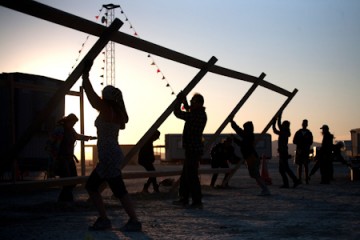
Operation Morning Wood: On occasion, Shade Crew begins work before sunrise, at 4:30 am. Via The Burning Blog. Courtesy John Curley.
Despite the pervasive machismo necessary to work long hours in triple-digit temperatures, most DPW volunteers were initially drawn in by the Burning Man event, which means that for the most part, it is a group of very creative, playful, and artistic individuals. While our job is to facilitate the art and artists of Burning Man, we have the opportunity to create our own art works for what is known as “Early Burn.” Two weeks before The Man burns, DPW has its own mini-Burning Man, wherein each crew builds a giant flammable sculpture, loads it with pyrotechnic explosives, and burns it.
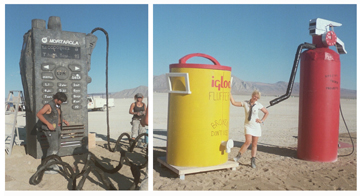
Left: Heavy Equipment built a giant working radio. Right: the author, with the giant Igloo and Fire Extinguisher effigies that she built with the Fluffer Team and Special Projects. Courtesy Shane Stacy aka Alabama.
Despite my work with the Shade Crew, my Fluffer loyalty led me to work with them to build a giant version of the Igloo water coolers we haul around the playa. Since the Fluffers do not usually do carpentry work, we lacked lumber, tools, and supplies. So we teamed up with the Special Projects Crew, helping them build a ten-foot tall fire extinguisher in exchange for help with our seven-foot-tall Igloo. For some extra pyrotechnic flair, we decided to run fuel pipes up through the fire extinguisher, so that it would pump fuel out of the hose and ignite our firework-filled water cooler—hence the title for our piece, “Oh, the Firony!” Like Team Firony’s piece, much of the work had a Claes Oldenberg oversized-object motif—a huge exploding banana from the Commissary Crew, a mammoth working radio/walkie-talkie built by the Heavy Equipment Crew, a giant breaker built by the Power Crew, and an irreverent oversized sign by the Sign Shop reading “Fuck Your Sign.” The latter piece was the only effigy that faced an insurmountable pyrotechnic challenge, refusing to catch fire, and was eventually stolen by pranksters. The theft was perfect, since Burning Man tradition dictates the stealing of all of Sign Shop’s beautiful street signs on the night the Man burns.

Fire Extinguisher, Water Cooler, Breaker, Banana, and Radio Effigies go up in flames at Early Burn. Via The Burning Blog. Courtesy John Curley.
While nearly one month of working in the desert might seem like a lot, roughly half of the DPW crew stays for another month following the event. After a week of tear-down, the Playa Restoration Team gets started. In 2004, crew manager D.A. changed the name of the work force from “Cleanup Crew” to “Restoration” to reinforce that the real responsibility for cleaning up and leaving no trace lies with Burning Man’s participants. The role of the DPW Restoration Team is not to pick up trash, but to truly return the playa to its natural state, which includes big jobs like busting dunes created by Burning Man traffic, to small details, like sifting out every last bit of sawdust. The process involves “line sweeps,” wherein, every day, crew members line up shoulder to shoulder and march across the playa, scrutinizing the ground and removing every shred of MOOP. Each year, the crew works together to create a map showing the various concentrations of MOOP, so that participants can determine if their camp successfully left no trace. During the weeks of Restoration, the map is updated live, and you can follow the developments via The Hun’s posts on the official Burning Man Blog. After weeks of the Restoration Team’s hard work, the Bureau of Land Management inspects the playa by sampling certain areas. If those sampled areas show virtually no MOOP, Burning Man is deemed a successful Leave No Trace event, and the permits are renewed for the coming year. Luckily, thanks to the Resto Crew, we passed inspection two weeks ago, which means another Burn in 2012—and another DPW work season!
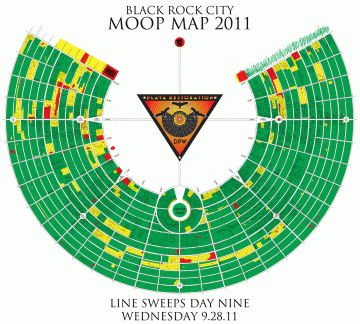
Most recent (but not final) Moop Map, created by The Playa Restoration Team. Courtesy The Burning Blog and The Hun.
“DPW ruined my life” is one of the crew’s frequently-invoked sayings. Escaping to the off-grid desert for 1 or 2 months every year is not necessarily conducive to maintaining stable careers, relationships, and lifestyles in the default world. But DPW crew members tend to get hooked and find a way to stick with it. Hopefully I will get the chance to return next summer for the month of set-up, and stay another month for restoration. So yes, DPW definitely ruined my life.
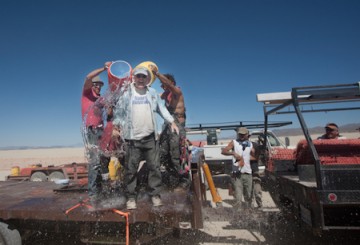
Just George, Fence Manager, gets doused at the end of Fence Day. Via The Burning Blog. Courtesy John Curley.




Pingback: Looking at Los Angeles | Top 5 of 2011: Entertainers Who Moonlight as Artists | Art21 Blog